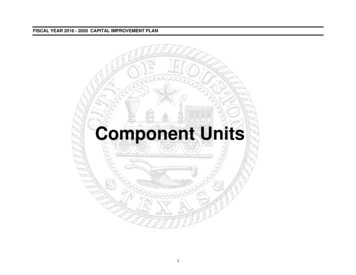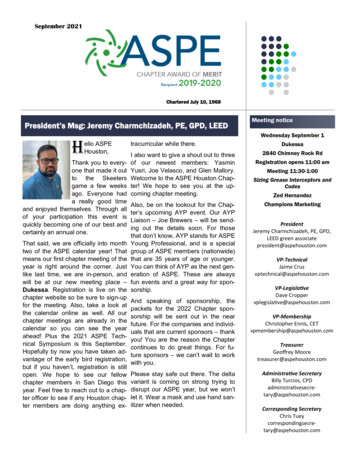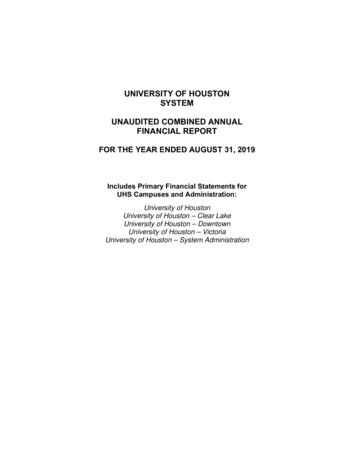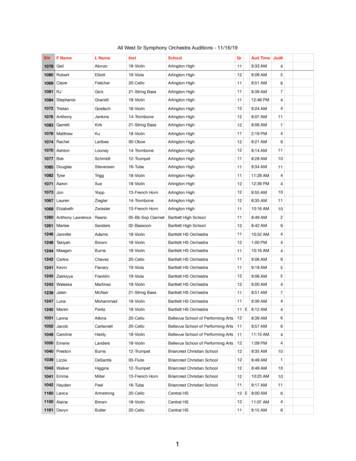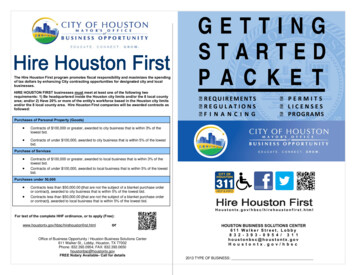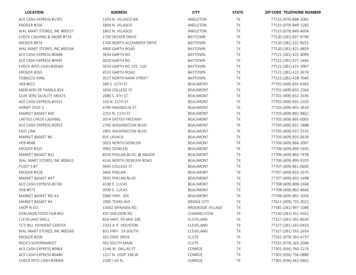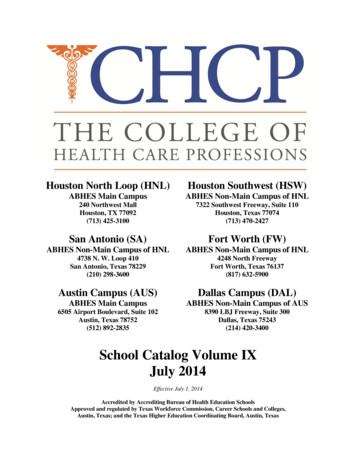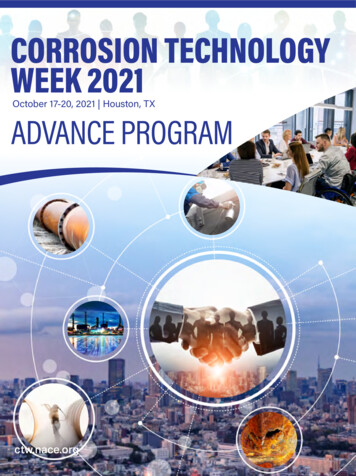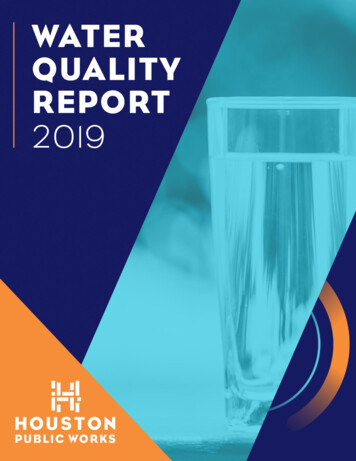
Transcription
HOUSTON WATER QUALITY REPORT JAN - DEC 2019The U.S. Environmental Protection Agency (EPA) requires that all drinking water suppliers provide a DrinkingWater Quality Report to their customers on an annual basis.This annual water quality report includes important information regarding drinking water. For assistance inEnglish, please call 311.Este reporte incluye información importante sobre el agua para tomar. Para asistencia en español, favor dellamar al 311.Bảng Báo Cáo Chất Lượng Nước hàng năm này cung cấp thông tin về nước uống. Để được trợ giúp bằngtiếng Việt, xin vui lòng gọi số 311.Ce rapport annuel sur la Qualité de l’Eau fournit des informations sur l’eau potable. Pour de l’assistance enfrançais, appelez le 311.311 برشال هايم صخت تامولعم ىلع يوتحي هايمال ةدوج ريرق ت . ةيبرعال ةغلالب ةدعاسملل ، ب الصتاال ءاجرال �的資訊。如需中文協助,請撥 311.The City of Houston delivers drinking water of the highest quality through six community public water systems.Houston Water Quality Report 20192
PUBLIC PARTICIPATIONThere are many opportunities for public participation. Information on Houston City Council meetings is availableat houstontx.gov/citysec. To find out more about Houston Water Education & Outreach visitpublicworks.houstontx.gov/waterworks.WATER SOURCESCustomers of Houston Water Main System receive their drinking water from three water purification plants and40 ground water plants. 16 additional groundwater plants provide for the remaining 5 Houston Water Systems.The City of Houston treats the water according to federal and state standards to remove harmful contaminants.The sources of drinking water nationwide (both tap water and bottled water) include rivers, lakes, streams,ponds, reservoirs, springs, and wells. As water travels over the surface of the land or through the ground, itdissolves naturally-occurring minerals and can be polluted by animals or human activity. Contaminants that maybe present in source water include: microbial contaminants, such as viruses and bacteria; inorganiccontaminants, such as salts and metals; pesticides and herbicides, which may come from agriculture, stormwater run- off, and residential uses; organic chemicals, from industrial or petroleum use; and naturally-occurringradioactive materials. In order to ensure that tap water is safe to drink, the EPA prescribes regulations that limitthe amount of certain contaminants in water provided by public water systems. The Food and DrugAdministration regulations establish limits for contaminants in bottled water that must provide the sameprotection for public health.Contaminants may be found in drinking water that may cause taste, color, or odor problems. These types ofproblems are not necessarily causes for health concerns. For concerns with taste, odor or color of drinkingwater, contact 311 or email waterquality@houstontx.gov.Drinking water, including bottled water, may reasonably be expected to contain at least small amounts of somecontaminants. The presence of contaminants does not necessarily indicate that the water poses a health risk.More information about contaminants and potential health effects can be obtained by calling the EPA’s SafeDrinking Water Hotline (800.426.4791).UNREGULATED CONTAMINANTSUnregulated contaminants do not have EPA-established drinking water standards. The purpose of monitoringthese contaminants is to assist the EPA in determining if future regulation is warranted. For more informationvisit epa.gov/dwucmr.SPECIAL NOTICESome people may be more vulnerable to certain microbial contaminants such as Cryptosporidium, indrinking water. Infants, some elderly or immunocompromised persons such as those undergoingchemotherapy for cancer; those who have undergone organ transplants; those who are undergoingtreatment with steroids; and people with HIV/AIDS or other immune system disorders can beparticularly at risk from infections. These people should seek advice about drinking water from aphysician or health care provider. Additional guidelines on appropriate means to lessen the risk ofinfection by Cryptosporidium are available from the Safe Drinking Water Hotline (800.426.4791).Houston Water Quality Report 20193
ARSENICHouston's Main drinking water contains low levels of arsenic, which is below the state and federal action levels.EPA's standard balances arsenic's possible health effects against the costs of removing it from drinking water.EPA continues to research the health effects of low levels of arsenic, which is a mineral known to cause cancerin humans at high concentrations and is linked to other health effects such as skin damage and circulatoryproblems.LEADIf present, elevated levels of lead can cause serious health problems, especially for pregnant women and youngchildren. Lead in drinking water is primarily from materials and components associated with service lines and inhome plumbing. The City of Houston is responsible for providing high quality drinking water but cannot controlthe variety of materials used in in-home plumbing components. When water in your home plumbing has beensitting for several hours, you can minimize the potential for lead exposure by flushing your tap for one to twominutes before using water for drinking or cooking. If you are concerned about lead in your water, you may wishto have your water tested. Information on lead in drinking water, testing methods, and steps you can take tominimize exposure is available from the Safe Drinking Water Hotline (800.426.4791) or atepa.gov/safewater/lead.WATER LOSSThe Infrastructure Leak Index (ILI) measures the efficiency of water loss control efforts. It is calculated by takingthe real losses (water lost due to leaks) and dividing them by the unavoidable real losses, the theoretical level ofminimum leakage calculated by American Water Works Association Standards. Houston Water’s ILI is based onthe combination of all six community public water systems. In 2019, Houston Water’s ILI was 9.22.CONTACT USQuestions about this report or your water quality? Please email waterquality@houstontx.gov or call 3-1-1(713.837.0311) and ask to speak with a member of the Water Quality team.Photo by Tim MarshallHouston Water Quality Report 20194
Parameter/Substance (units)(sampled in 2019 unless noted)Highest LevelAllowed(EPA’s MCL)Ideal Goal(EPA’s .0380.20.4014MONITORED AT WATER PLANTSArsenic1 (ppb)Atrazine (ppb)Barium (ppm)Chromium (ppb)Combined Uranium (ppb)Cyanide (ppm)1032100300.203210000.2NDND0.02NDFluoride (ppm)Gross Alpha (pCi/L)Nitrate (ppm)Selenium (ppb)Simazine (ppb)415105044010504ND(TT) 95% ofmonthly samples 0.3 NTUNATurbidity (NTU)ND0.080.30.734ND0.21.0ND213ND0.00.2Lowest Monthly Percentage 0.3 NTU: 96%Highest Single Measurement:0.52 NTUMONITORED IN DISTRIBUTION SYSTEMChloramines (Disinfectant)(ppm)Haloacetic Acids (ppb)Total Trihalomethanes (ppb)4.0 (MRDL)Yearly Average(LRAA) 60Yearly Average(LRAA) 80 4.0 (MRDLG)NANA0.13.04.8Highest LRAA: 38.63 ppbIndividual sample results rangefrom 6.0 ppb (not detected) to49.6 ppb.Highest LRAA: 41.7 ppb Individualsample results range from 6.0 ppb(not detected) to 59.6 ppb.MONITORED AT CUSTOMER TAPLead (ppb)AL 90% below15 ppb (TT)090% below 4.01 ppbTwo samples above 15 ppbCopper (ppm)AL 90% below1.3 ppm (TT)1.390% below 0.13 ppmNo samples above 1.3 ppmHouston Water Quality Report 20195
SECONDARY STANDARDSParameter/Substance (units)Recommended Levels (SMCL)DetectionsMinimum Average MaximumAluminum (ppm)0.2ND0.133.39Chloride (ppm)2501635591ND0.0070.121Texas Copper (ppm)Fluoride (ppm)2ND0.270.74Iron (ppm)0.3ND0.162.64Manganese (ppm)0.05ND0.010.056.5 - 8.57.47.99.2Sulfate (ppm)25041943Total Dissolved Solids (ppm)500127240362Total Hardness as CaCO3 (ppm)NA481232145ND0.0050.047Dates m (ppb)Jan – Dec 2019Jan – Dec 2019ND0.581.57Manganese (ppb)Jan – Dec 2019ND7.848.7Bromide (ppb)Jan – Dec 2019ND2283130HAA5 (ppb)Jan – Dec 20190.3529.9975.74HAA6Br (ppb)Jan – Dec 2019ND7.0213.04HAA9 (ppb)Jan – Dec 20190.3535.9781.33Total Organic Carbon (ppb)Jan – Dec 2019ND678718800Anatoxin-A (ppb)Jan – Dec 2019ND0.1290.405pHZinc (ppm)UNREGULATED CONTAMINANTSParameter/Substance (units)O-Toluidine (ppb)Main System – December 2019 Monitoring and Reporting ViolationIn Jan 2020 the Main System received a monitoring violation for the month of Dec 2019 for failure to collectrequired monthly samples for total coliform2. In Dec 2019 the system collected 418 of the 420 samplesrequired for the month. The violation was for failure to meet the sample schedule and was not related to theresults of the total coliform tests. The system collected all required monthly samples in Jan 2020. The systemwas returned to compliance by the TCEQ on Feb 7, 2020 after evaluating that Jan 2020 samples met therequired schedule.Notes1 For more background information regarding Arsenic – please refer to page 4.2 Coliform is a type of bacteria that is naturally present in the environment. Water systems are required tomonitor for coliform routinely, and if detected, it triggers further tests for potentially harmful bacteria, andcan trigger assessments to look for potential causes or problems.3 Only one sample was required to be taken for this analyte during 2019.Houston Water Quality Report 20196
Parameter/Substance (units)(sampled in 2019 unless noted)Highest LevelAllowed(EPA’s MCL)Ideal Goal(EPA’s MCLG)DetectionsMinimumAverageMaximumMONITORED AT WATER PLANTSBarium (ppm)22Combined Radium (pCi/L) 20171500.32ND0.3Fluoride (ppm)440.22Gross Alpha (pCi/L)1503.42Xylenes, Total (ppb)10,00010,000ND0.21.00.8MONITORED IN DISTRIBUTION SYSTEMChlorine (Disinfectant) (ppm)Haloacetic Acids (ppb)Total Trihalomethanes (ppb)4.0 (MRDL) 4.0 (MRDLG)Yearly Average(LRAA) 60Yearly Average(LRAA) 80NANA.91.42.9Highest LRAA: 2.8 ppb. Individualsample results range from 6.0 ppb(not detected) to 5.5 ppb.Highest LRAA: 7.55 ppb. Individualsample results range from 6.0 ppb(not detected) to 15.2 ppb.MONITORED AT CUSTOMER TAPLead (ppb)Copper (ppm)AL 90%below 15 ppm(TT)AL 90%below 1.3 ppm(TT)090% below 0 ppb.1 samples above 15 ppb1.390% below 0.252 ppm.No sample above 1.3 ppmSECONDARY STANDARDSParameter/Substance (units)Recommended Levels (SMCL)MinimumDetectionsAverageMaximumChloride (ppm)250212431Iron (ppm)0.3ND0.00.2Manganese (ppm)0.05ND0.010.086.5 - 8.57.37.78.5Sulfate (ppm)25057.613Total Dissolved Solids (ppm)500154191228pHTexas Copper (ppm)Total Hardness as CaCO3 (ppm)Zinc (ppm)Houston Water Quality Report 20191NA50.00621051170.00521487
UNREGULATED CONTAMINANTSParameter/Substance (units)Dates MonitoredMinimumAverageMaximum1-Butanol (ppb)July 2018 - March 2019ND22Germanium (ppb)July 2018 - March 2019ND0.320.34Manganese (ppb)July 2018 - March 20193.725.949BromideJuly 2018 - March 201924.252.9162HAA5July 2018 - March 2019ND1.404.85HAA6BrJuly 2018 - March 2019ND0.792.41HAA9July 2018 - March 2019ND1.936.58Notes1 Subject to reduced monitoring requirements. Detected contaminant within the past five years, in theyear indicated.2 Only one sample was required to be taken for this analyte during 2019.Photo by Alex PerezHouston Water Quality Report 20198
Parameter/Substance (units)(sampled in 2019 unless noted)Highest LevelAllowed(EPA’s MCL)Ideal Goal(EPA’s MCLG)DetectionsMinimumAverageMaximumMONITORED AT WATER PLANTSArsenic1 (ppb)Barium (ppm)0222.230.220.250.283003.83Fluoride (ppm) 20182440.13Gross Alpha (pCi/L) 201821502.03Gross Beta (pCi/L) 201825004.53Nitrate (ppm)10100.20.20.3Selenium (ppb)5050ND2.75.40.61.32.2Combined Uranium (ppb)2018210MONITORED IN DISTRIBUTION SYSTEMChlorine (Disinfectant) (ppm)4.0 (MRDL) 4.0 (MRDLG)Haloacetic Acids (ppb)Yearly Average(LRAA) 60NATotal Trihalomethanes (ppb)Yearly Average(LRAA) 80NAHighest LRAA: ND (not detected)All individual sample results wereND.Highest LRAA: 1.45 ppbIndividual sample results range from 6.0 ppb (not detected) to 5.8 ppbMONITORED AT CUSTOMER TAPLead (ppb) 20172Copper (ppm) 20172AL 90%below15 ppm (TT)AL 90%below1.3 ppm (TT)090% below 0 ppbNo sample above 15 ppb1.390% below 0.162 ppmNo sample above 1.3 ppmSECONDARY STANDARDSParameter/Substance (units)Chloride (ppm)20182pH 20182Total Dissolved Solids (ppm)20182Total Hardness as CaCO3(ppm)Sulfate (ppm) 20182Houston Water Quality Report 2019Recommended Levels (SMCL)MinimumDetectionsAverageMaximum2505336.5 - 8.57.435002813NA250168171.5175739
UNREGULATED CONTAMINANTSParameter/Substance (units)Dates MonitoredMinimumAverageMaximumManganeseApril - October 2018ND0.80.8BromideApril - October 2018113160191HAA5April - October 2018ND0.110.63HAA6BrApril - October 2018ND0.311.09HAA9April - October 2018ND0.381.09Notes1 For more background information regarding Arsenic – please refer to page 4.2 Subject to reduced monitoring requirements. Detected contaminant within the past five years, in the yearindicated.3 Only one sample was required to be taken for this analyte during 2019.Photo by Ethan SykesHouston Water Quality Report 201910
Highest LevelAllowed(EPA’s MCL)Parameter/Substance (units)(sampled in 2019 unless noted)Ideal Goal(EPA’s MCLG)DetectionsMinimumAverageMaximumMONITORED AT WATER PLANTSArsenic1 (ppb)Barium (ppm)Combined Uranium (ppb) 20172Fluoride (ppm) 20172Gross Alpha (pCi/L) 20172Gross Beta (pCi/L) 20172Nitrate (ppm)Selenium (ppb) 20172Xylenes, Total 172NDND1.5MONITORED IN DISTRIBUTION SYSTEMChlorine (Disinfectant)4.0 (MRDL) 4.0 (MRDLG)Haloacetic Acids (ppb)YearlyAverage (LRAA) 60NATotal Trihalomethanes (ppb)YearlyAverage (LRAA) 80NAHighest LRAA: 1.9 ppbIndividual sample results range from 6.0 ppb (not detected) to 1.9 ppb.Highest LRAA: 9.6 ppbIndividual sample results range from 6.0 ppb (not detected) to 9.6 ppb.MONITORED AT CUSTOMER TAPAL 90% below15 ppb (TT)AL 90% below1.3 ppm (TT)Lead (ppb) 20172Copper (ppm) 2017201.390% below 3.31 ppb.One sample above 15 ppb.90% below 0.13 ppm.No sample above 1.3 ppmSECONDARY STANDARDSParameter/Substance (units)Recommended Levels (SMCL)Chloride (ppm) 20172250Iron (ppm)0.3pH20172Sulfate (ppm)20172Total Dissolved Solids (ppm)20172Total Hardness as CaCO3 (ppm)Minimum19DetectionsAverageMaximum21230.1836.5 - 8.57.67.98.125044.55500188190191NA993Notes1 For more background information regarding Arsenic – please refer to page 4.2 Subject to reduced monitoring requirements. Detected contaminant within the past five years, in theyear indicated.3 Only one sample was required to be taken for this analyte during 2019.Houston Water Quality Report 201911
Parameter/Substance (units)(sampled in 2019 unless noted)Highest LevelAllowed(EPA’s MCL)DetectionsIdeal Goal(EPA’s MCLG)MinimumAverageMaximumMONITORED AT WATER PLANTSBarium (ppm) 20181220.22Nitrate (ppm)10100.22MONITORED IN DISTRIBUTION SYSTEMChlorine (Disinfectant)4.0 (MRDL) 4.0 (MRDLG)Haloacetic Acids (ppb)Yearly Average(LRAA) 60NATotal Trihalomethanes (ppb)Yearly Average(LRAA) 80NA1.01.42.1Highest LRAA: 2.7 ppb.Individual sample results range from1.2 to 2.7 ppb.Highest LRAA: 32.7 ppb.Individual sample results range from3.5 to 32.7 ppb.MONITORED AT CUSTOMER TAPAL 90% below15 ppb (TT)Lead (ppb)AL 90% below1.3 ppm (TT)Copper (ppm)090% below 3.54 ppb.No sample above 15 ppb1.390% below 0.116 ppm.No sample above 1.3 ppmSECONDARY STANDARDSParameter/Substance (units)Chloride (ppm)20181Iron (ppm) 20181Ph 20181Sulfate (ppm) 20181Total Dissolved Solids(ppm) 20181Total Hardness as CaCO3(ppm) 20181Recommended Levels 26.5 - 8.57.72250225001762NA1062Notes1 Subject to reduced monitoring requirements. Detected contaminant within the past fiveyears, in the year indicated.2 Only one sample was required to be taken for this analyte during 2019.Houston Water Quality Report 201912
Parameter/Substance (units)(sampled in 2019 unless noted)Highest LevelAllowed(EPA’s MCL)Ideal Goal(EPA’s MCLG)DetectionsMinimumAverageMaximumMONITORED AT WATER PLANTSArsenic1 (ppb)Barium (ppm)10202Nitrate (ppm)Selenium (ppb)Simazine 73.0MONITORED IN DISTRIBUTION SYSTEMChloramines (Disinfectant)4.0 (MRDL) 4.0 (MRDLG)Haloacetic Acids (ppb)Yearly Average(LRAA) 60NATotal Trihalomethanes (ppb)Yearly Average(LRAA) 80NAHighest LRAA: 9.7 ppb.Individual sample results rangefrom 1.2 ppb to 12 ppb.Highest LRAA: 11.43 ppb.Individual sample results range from7.8 ppb to 14.8 ppb.MONITORED AT CUSTOMER TAPLead (ppb)Copper (ppm)AL 90%below 15 ppb (TT)AL 90%below 1.3 ppm (TT)090% below 0 ppb.No sample above 15 ppb1.390% below .364 ppm.No sample above 1.3 ppmSECONDARY STANDARDSParameter/Substance (units)Chloride (ppm) 20172Iron (ppm)Manganese (ppm)Ph 20172Texas Copper (ppm)Total Dissolved Solids (ppm)20172Total Hardness as CaCO3(ppm)Zinc (ppm)Recommended Levels (SMCL)2500.30.056.5 – 0.130.0137.80.0083263NA124350.0238.2295Notes1 For more background information regarding Arsenic – please refer to page 4.2 Subject to reduced monitoring requirements. Detected contaminant within the past five years, in theyear indicated.3 Only one sample was required to be taken for this analyte during 2019.Houston Water Quality Report 201913
CONTAMINANT SOURCESArsenicerosion of natural deposits; runoff from orchards; runoff from glass and electronics production wastesAtrazinerunoff from herbicide used on row cropsBariumChlorine &ChloraminesChromiumdischarge of drilling wastes; discharge from metal refineries; erosion of natural depositsCombined Radiumerosion of natural depositsCombined Uraniumerosion of natural depositsCoppercorrosion of household plumbing systems; erosion of natural depositsCyanideGross Alphadischarge from steel/metal factories; discharge from plastic and fertilizer factorieserosion of natural deposits; water additive which promotes strong teeth; discharge from fertilizer andaluminum factorieserosion of natural depositsGross Betadecay of natural and man-made depositsLeadcorrosion of household plumbing systems; erosion of natural depositsNitrate / Nitriterunoff from fertilizer use; leaching from septic tanks, sewage; erosion of natural depositsSeleniumdischarge from petroleum and metal refineries; erosion of natural deposits; discharge from minesSimazineTotal Haloacetic Acids(HAAs)Total Trihalomethanes(TTHMs)Turbidityherbicide runoffXylenesdischarge from petroleum factories; discharge from chemical factoriesFluoridewater additives used to control microbesdischarge from steel and pulp mills; erosion of natural depositsby-product of drinking water disinfectionby-product of drinking water disinfectionsoil DLGNANDNTUpCi/LppbppmSMCLTTdibromoacetic acid, dichloroacetic acid, monobromoacetic acid, monochloroacetic acid, trichloroacetic acidbromochloroacetic acid, bromodichloroacetic acid, dibromoacetic acid, dibromochloroacetic acid, monobromoaceticacid, tribromoacetic acidbromochloroacetic acid, bromodichloroacetic acid, chlorodibromoacetic acid, dibromoacetic acid, dichloroaceticacid, monobromoacetic acid, monochloroacetic acid, tribromoacetic acid, trichloroacetic acidLocational Running Annual Average - average of results taken at specific monitoring location during previous fourquartersMaximum Contaminant Level - highest level of a contaminant allowed. MCLs are set as close to MCLGs using bestavailable treatment technologyMaximum Contaminant Level Goal - level of a contaminant in drinking water below which there is no known orexpected risk to health. MCLGs allow for a margin of safetyMaximum Residual Disinfectant Level - highest level of a disinfectant allowed in drinking water. There is convincingevidence that addition of a disinfectant is necessary for control of microbial contaminantsMaximum Residual Disinfectant Level Goal - level of drinking water disinfectant below known or expected healthrisk. MRDLGs do not reflect the benefits of the use of disinfectants to control microbial contaminantsNot ApplicableNot DetectedNephelometric Turbidity UnitsPico Curies per liter (measure of radioactivity)Parts Per Billion or micrograms per liter (μg/L)Parts Per Million or milligrams per liter (mg/L)Secondary Maximum Contaminant Limit - National Secondary Drinking Water Standards are non-enforceableguidelines regulating contaminants that may cause cosmetic or aesthetic effects in drinking water. The EPArecommends secondary standards but does not require systems to comply with limitsTreatment Technique - required process intended to reduce the level of a contaminant in drinking waterfollow us on social @HouPublicWorksthis water quality report is available at bit.ly/waterquality2019prior water quality reports are available at bit.ly/houwaterqualityHouston Water Quality Report 201914
Houston Water Quality Report 2019 2 HOUSTON WATER QUALITY REPORT JAN - DEC 2019 The U.S. Environmental Protection Agency (EPA) requires that all drinking water suppliers provide a Drinking . Information on lead in drinking water, testing methods, and steps you can take to minimize exposure is available from the Safe Drinking Water Hotline .
